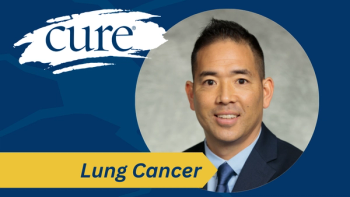Among patients with stage 1a to 2a nonsquamous non–small cell lung cancer (NSCLC) identified as high risk by a 14-gene molecular assay who received adjuvant chemotherapy, the interim analysis of the international AIM-HIGH trial revealed a substantial improvement in disease-free survival (DFS) at 24 months, according to data presented at the 2025 ASCO Annual Meeting.
At 24 months, 96% of patients in the chemotherapy arm were alive without disease progression compared with 79% in the observation arm.
A similar improvement in DFS was observed in patients with stage 1a disease. In the chemotherapy arm, 98% of patients were alive without disease progression versus 78% in the observation arm.
"This is the first prospective randomized trial to show improvement in disease-free survival with a molecular risk discriminator in stage 1a through 2a nonsquamous non–small cell lung cancer,” Dr. David Spigel, said during the presentation. “Interim analysis was designed to detect a large discrepancy in outcomes between treated and untreated patients."
Glossary:
Disease-free survival (DFS): time a patient lives without signs of cancer after treatment.
Adjuvant chemotherapy: additional treatment given after surgery to lower the risk of cancer returning.
RiskReveal: a 14-gene test that evaluates lung cancer tumors to predict risk of early recurrence.
ECOG performance status: scale used to assess a patient’s ability to perform daily activities.
Spigel, chief scientific officer at Sarah Cannon Research Institute in Nashville, Tennessee, who presented the findings, highlighted the need for improved outcomes in early-stage NSCLC, noting that the 5-year DFS for even stage 1a disease remains under 65%, contributing to over 100,000 deaths worldwide. While adjuvant therapy is common in later stages, it is not typically recommended for stage 1a and often deferred in stages 1b and 2a.
“RiskReveal is a 14-gene lung cancer assay that examines the gene expression profile for nonsquamous non–small cell lung cancer and is used to identify patients at high risk of early disease. This assay has been prospectively validated in over 1400 patients with nonsquamous non–small cell lung cancer. Identifying patients who are at highest risk of recurrence is a priority in the treatment of non–small cell lung cancer,” Spigel explained.
The AIM-HIGH trial enrolled patients aged 18 years and older with completely resected stage 1a, 1b or 2a nonsquamous NSCLC. Following surgery, tumor tissue was analyzed using a commercially available 14-gene prognostic assay to identify patients at high or intermediate risk of early recurrence. Patients identified as low risk were not included in the study.
The trial randomized high-risk patients to either observation (the standard of care) or four cycles of platinum-based doublet chemotherapy per local standards. Immunotherapy and tyrosine kinase inhibitors were permitted at the investigator's discretion for appropriate patients.
The primary end point of the study was DFS, with routine CT scans and surveillance conducted for 5 years or until recurrence or death.
The interim analysis, which led to early stopping of the trial by the independent data safety monitoring board due to the significant difference observed, included 89 patients in the adjuvant chemotherapy arm and 111 patients in the control arm. Baseline characteristics, including gender, smoking history (predominantly former or current smokers), ECOG performance status (0 or 1), and stage of cancer (1a, 1b, 2a), were well balanced between the two arms.
Specifically, the median age of patients in the adjuvant chemotherapy arm was 63 years versus 66 in the observation arm, 47% of patients in both arms were female, 90% and 86% had a history of smoking, 67% and 65% had an ECOG performance status of 0, 31% and 34% had an ECOG performance status of 1, and 1% in each arm had an unknown ECOG performance status, respectively. A total of 97% of patients in the adjuvant chemotherapy arm had a histology of adenocarcinoma versus 93% in the control arm, and most patients had stage 1b disease (39% versus 41%).
The types of resections (primarily lobectomy) and the choice of adjuvant chemotherapy regimens were also balanced. The side effects observed in the chemotherapy arm were also consistent with the known profiles of platinum-based doublet chemotherapy.
Spigel concluded that the AIM-HIGH trial demonstrated that utilizing this 14-gene assay to precisely direct systemic adjuvant therapy in stage 1a through 2a nonsquamous NSCLC has the potential to substantially reduce the rates of early recurrence and death.
“Utilization of this 14-gene assay to precisely direct systemic adjuvant therapy in stage 1a through 2a nonsquamous non–small cell lung cancer may substantially reduce the rates of early recurrence and death,” Spigel said.
Reference:
"An international, multicenter, prospective randomized trial of adjuvant chemotherapy for stage 1A-2A non-small cell lung cancer identified as high risk by a 14-gene molecular assay" by Dr. David Spigel, et al., American Society of Clinical Oncology Annual Meeting.
For more news on cancer updates, research and education, don’t forget to subscribe to CURE®’s newsletters here.






